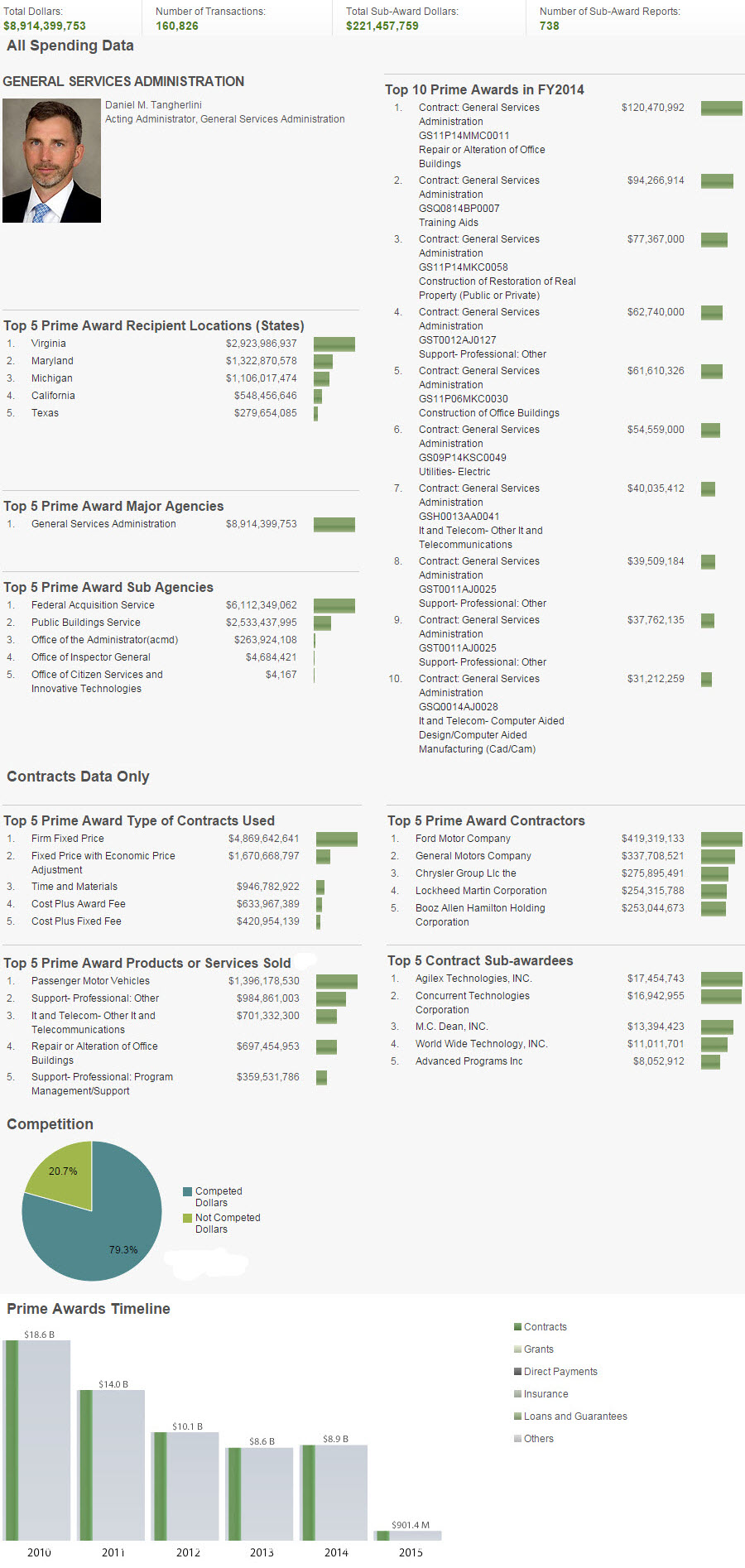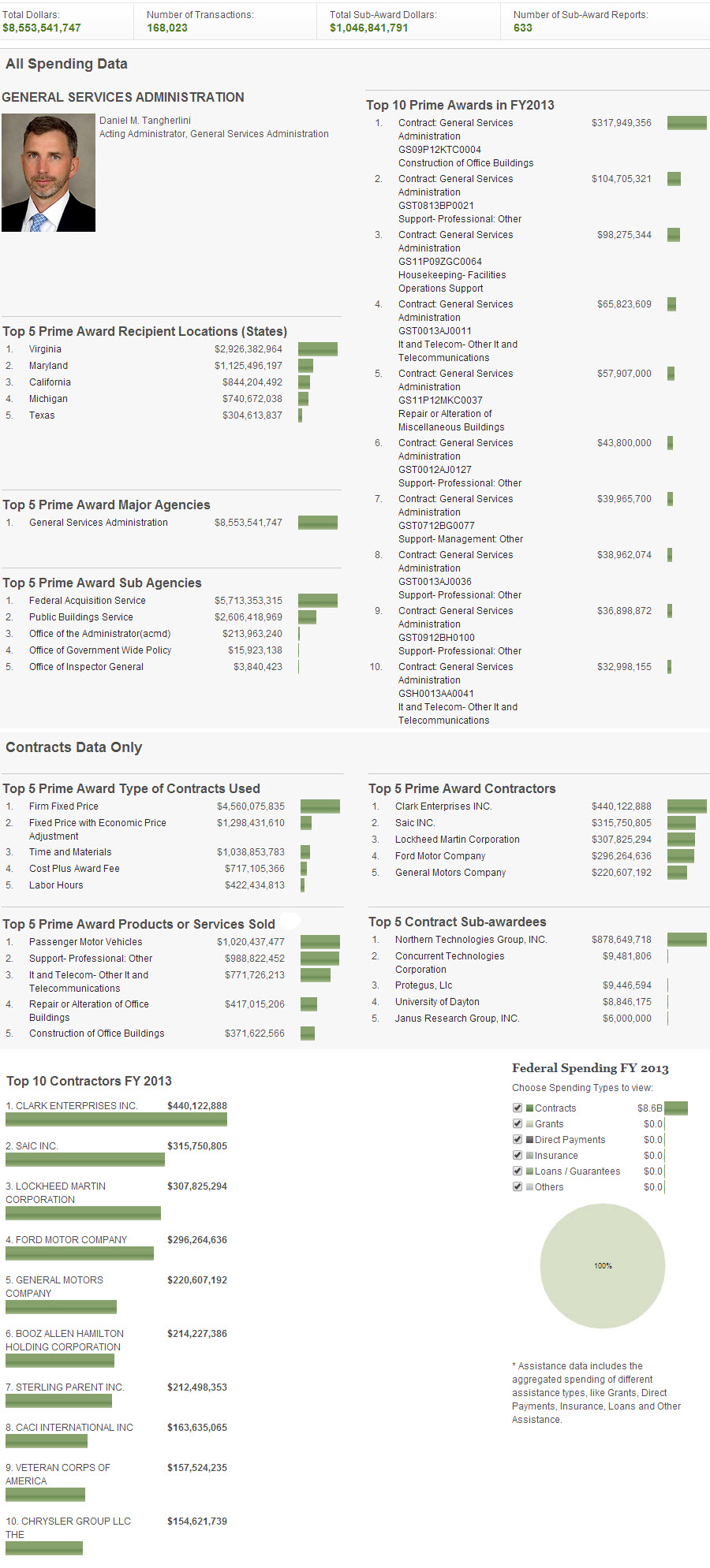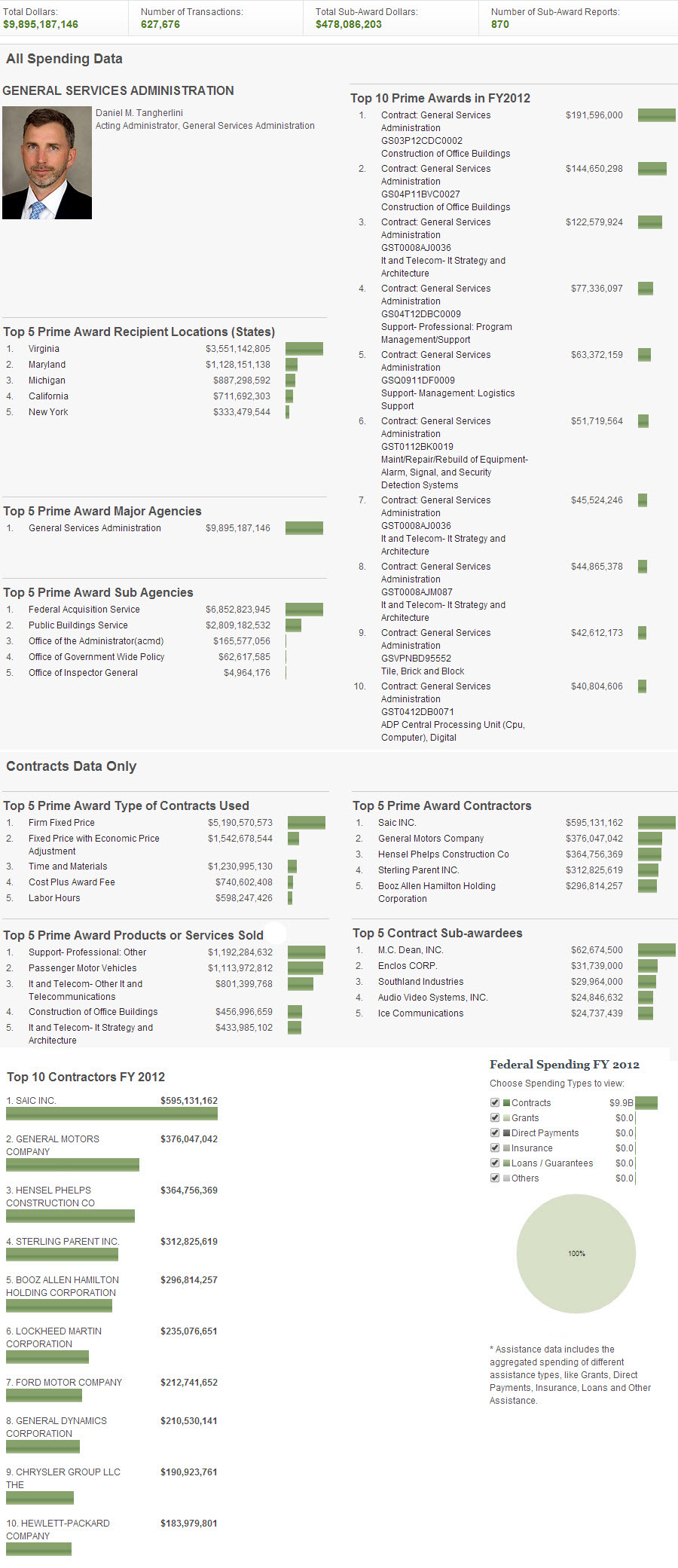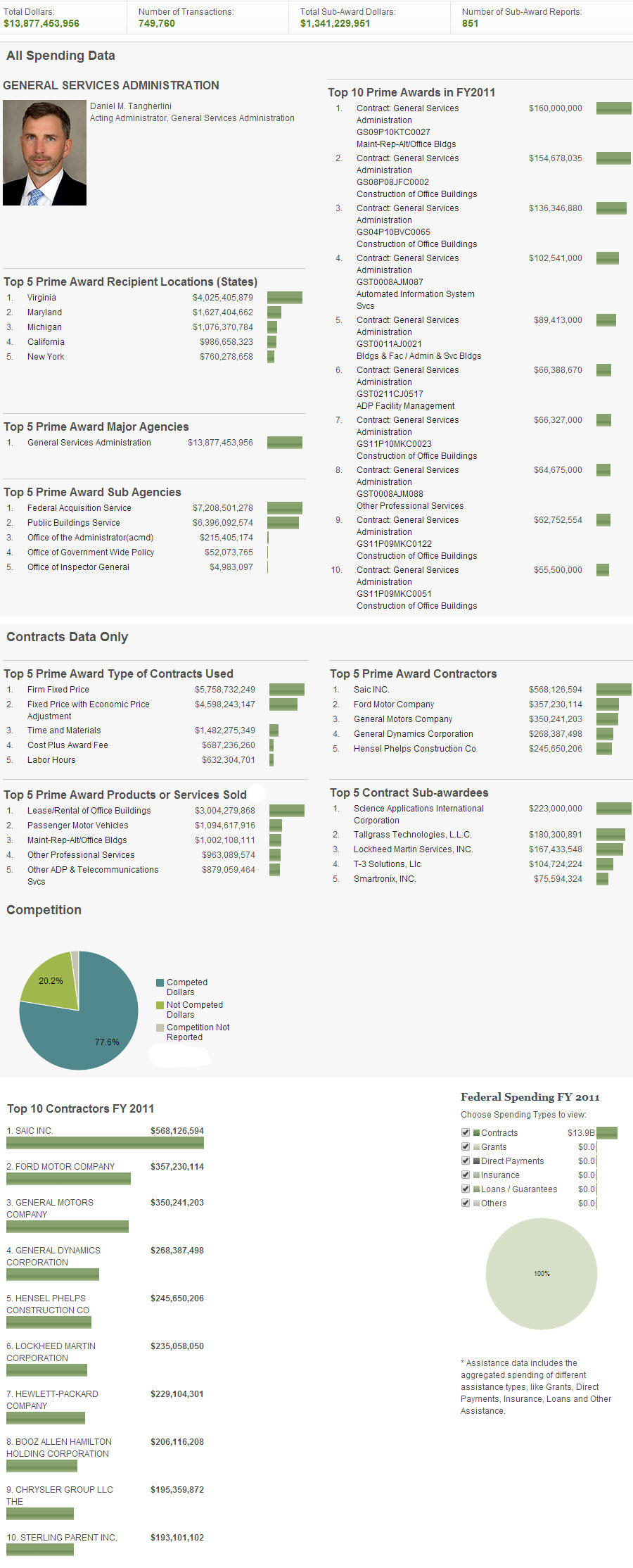Agencies use the goals in agency strategic plans and annual performance plans to inform annual budget decisions, longer-term investment planning, and human resource planning. The agency’s strategic goals and objectives are listed below.
Strategic Goal: Savings
Objective: Leverage the government’s buying through government-wide contracting solutions to reduce costs.
Objective: Optimize the GSA real property inventory and improve the federal use of space.
Priority Goal: Manage customer agency real estate portfolio needs in a cost-effective and environmentally sustainable manner.
Goal Statement: Manage customer agency real estate portfolio needs in a cost-effective and environmentally sustainable manner.
By September 30, 2013, the General Services Administration (GSA) will complete and begin implementation of Customer Portfolio Plans (CPPs) with nine agencies to identify opportunities and develop action plans to optimize their real estate portfolios through reducing space, improving utilization and leveraging market opportunities to reduce costs. The six portfolio plans completed in FY11 and FY12 identified real estate opportunities that represent millions of dollars in savings.
Description: Federal agencies traditionally assess and make real estate decisions on a decentralized, property-by-property, basis. Local decisions that look to remain in current properties or move to new properties may not take into account all considerations. Customer Portfolio Planning engages each Agency in an evaluation of how current workspace is being used and provides a holistic portfolio of the Agency’s workspace priorities. These plans also provide an opportunity for GSA to recommend alternatives that take into account regional and national real estate market trends and changing workplace practices that promote better use of office, warehouse and other real property. In some cases, agencies can share properties to drive down costs and improve workspace conditions.
Objective: Reduce water consumption and energy use of GSA-managed real property.
Priority Goal: Manage customer agency real estate portfolio needs in a cost-effective and environmentally sustainable manner.
Goal Statement: Manage customer agency real estate portfolio needs in a cost-effective and environmentally sustainable manner.
By September 30, 2013, the General Services Administration (GSA) will complete and begin implementation of Customer Portfolio Plans (CPPs) with nine agencies to identify opportunities and develop action plans to optimize their real estate portfolios through reducing space, improving utilization and leveraging market opportunities to reduce costs. The six portfolio plans completed in FY11 and FY12 identified real estate opportunities that represent millions of dollars in savings.
Description: Federal agencies traditionally assess and make real estate decisions on a decentralized, property-by-property, basis. Local decisions that look to remain in current properties or move to new properties may not take into account all considerations. Customer Portfolio Planning engages each Agency in an evaluation of how current workspace is being used and provides a holistic portfolio of the Agency’s workspace priorities. These plans also provide an opportunity for GSA to recommend alternatives that take into account regional and national real estate market trends and changing workplace practices that promote better use of office, warehouse and other real property. In some cases, agencies can share properties to drive down costs and improve workspace conditions.
Objective: Reduce travel, fleet, building, and operational greenhouse gas.
Priority Goal: GSA will increase the sustainability of the Federal Supply Chain.
Goal Statement: GSA will increase the sustainability of the Federal Supply Chain.
GSA will increase the sustainability of the Federal supply chain by increasing the sale of green product and service offerings to 5 percent of total business volume. By September 30, 2013 GSA will increase the availability of green product and service offerings by 10 percent relative to its total inventory.
Description: Federal agencies have statutory and executive order requirements to:
- purchase products with preferred environmental or energy attributes,
- engage in electronics stewardship,
- reduce use of toxic and hazardous chemicals,
- increase the energy and water efficiency of Federal buildings,
- increase the energy efficiency of fleet vehicles, and
- reduce their greenhouse gas (GHG) emissions.
GSA, as an intermediary in the market, provides an avenue through which commercially available products and services can be delivered cost effectively to Federal agencies. In this role, GSA assists Federal agencies in meeting environmental sustainability purchasing requirements by identifying and increasing the availability of green products and services. GSA does not have the authority to mandate other Federal Agencies to purchase green, but through education and outreach, is able to influence federal green purchasing.
Expanding Green Offerings. By September 30, 2013, GSA will increase the number of green product and service offerings available to Federal customers by 10 percent (from 558,109 green offerings in FY 2010 to an estimated 613,920* green offerings in FY 2013). Considering statutory and executive order requirements, GSA applied the following criteria to identify green products and services.
- Green Products. Includes products that assist agencies to meet environmental purchasing requirements, products with an environmental icon, or products which adhere to environmental standards or certifications.
- Green Services. Services that involve the use of green products, or promote environmental sustainability goals, or including energy or environmental services.
Increasing Green Purchasing. By September 30, 2013, GSA will increase the purchasing of GSA green products and services to 5 percent of total business volume (from $1.29 billion in FY 2010 to an estimated $2.68 billion* in FY 2013). GSA, by raising awareness about tools such as the Green Products Compilation, will help agencies meet their sustainability goals and ultimately increase the sustainability of the Federal supply chain.
*Target numbers are calculated assuming the FY 2013 total number of offerings and total business volume remains at the FY 2010 level of 20.2 million offerings, and $53.55 billion in business volume. Actual target will vary based on the total offerings, and total business volume realized in FY 2013.
Objective: Enable government-wide operational excellence through analysis and policy-setting that drives efficiency, savings, and performance improvement.
Priority Goal: Drive greater transparency and openness in government.
Goal Statement: Drive greater transparency and openness in government.
Drive greater transparency and openness in government. By September 30, 2013, GSA will develop at least 10 new innovative, cost effective information technology solutions that increase government openness, including solutions to serve businesses with one-stop access to federal services, provide the public information about federal performance, engage the public in providing expertise on specific problems to Federal agencies, provide effective registration and management of government web sites, and streamline and leverage security assessments of innovative cloud computing products and solutions.
Description: GSA’s Office of Citizen Services and Innovative Technologies (OCSIT) develops new, innovative solutions for Federal agencies to better deliver their missions and enhance citizen engagement. An innovative solution is a new method, tool, or platform to solve a new or existing problem. By providing these shared government-wide solutions, OCSIT helps agencies save valuable resources, while improving operational efficiency. These solutions contribute to an open, citizen centric government. They enhance access to valuable government information and services by facilitating the exchange of ideas and knowledge between the government and the public.
For more information on GSA’s programs under this goal please click the links below:
American Job Center: jobcenter.usa.gov
BusinessUSA: business.usa.gov
Data.gov Open data government platform (OGPL): www.data.gov/opengovplatform
Digital Services Innovation Center: gsablogs.gsa.gov/dsic/2012/10/05/digital-analytics-program-helps-agencies-measure-web-performance/
Federal Data Center Consolidation Initiative (FDCCI): cio.gov/maximizing-value/data-center-consolidation/
FedRAMP.gov: fedramp.gov
HowTo.gov: www.howto.gov
Federal Infrastructure Projects Permitting Dashboard: permits.performance.gov
Social Media Registry (Agency): www.howto.gov/social-media/social-media-registry
Social Media Registry (Public): www.usa.gov/Contact/verify-social-media.shtml
Priority Goal: Manage customer agency real estate portfolio needs in a cost-effective and environmentally sustainable manner.
Goal Statement: Manage customer agency real estate portfolio needs in a cost-effective and environmentally sustainable manner.
By September 30, 2013, the General Services Administration (GSA) will complete and begin implementation of Customer Portfolio Plans (CPPs) with nine agencies to identify opportunities and develop action plans to optimize their real estate portfolios through reducing space, improving utilization and leveraging market opportunities to reduce costs. The six portfolio plans completed in FY11 and FY12 identified real estate opportunities that represent millions of dollars in savings.
Description: Federal agencies traditionally assess and make real estate decisions on a decentralized, property-by-property, basis. Local decisions that look to remain in current properties or move to new properties may not take into account all considerations. Customer Portfolio Planning engages each Agency in an evaluation of how current workspace is being used and provides a holistic portfolio of the Agency’s workspace priorities. These plans also provide an opportunity for GSA to recommend alternatives that take into account regional and national real estate market trends and changing workplace practices that promote better use of office, warehouse and other real property. In some cases, agencies can share properties to drive down costs and improve workspace conditions.
Priority Goal: Manage customer agency real estate portfolio needs in a cost-effective and environmentally sustainable manner.
Goal Statement: Manage customer agency real estate portfolio needs in a cost-effective and environmentally sustainable manner.
By September 30, 2013, the General Services Administration (GSA) will complete and begin implementation of Customer Portfolio Plans (CPPs) with nine agencies to identify opportunities and develop action plans to optimize their real estate portfolios through reducing space, improving utilization and leveraging market opportunities to reduce costs. The six portfolio plans completed in FY11 and FY12 identified real estate opportunities that represent millions of dollars in savings.
Description:Federal agencies traditionally assess and make real estate decisions on a decentralized, property-by-property, basis. Local decisions that look to remain in current properties or move to new properties may not take into account all considerations. Customer Portfolio Planning engages each Agency in an evaluation of how current workspace is being used and provides a holistic portfolio of the Agency’s workspace priorities. These plans also provide an opportunity for GSA to recommend alternatives that take into account regional and national real estate market trends and changing workplace practices that promote better use of office, warehouse and other real property. In some cases, agencies can share properties to drive down costs and improve workspace conditions.
Objective: Improve real property asset quality and shorten disposal cycle times.
Priority Goal: Drive greater transparency and openness in government.
Goal Statement: Drive greater transparency and openness in government.
Drive greater transparency and openness in government. By September 30, 2013, GSA will develop at least 10 new innovative, cost effective information technology solutions that increase government openness, including solutions to serve businesses with one-stop access to federal services, provide the public information about federal performance, engage the public in providing expertise on specific problems to Federal agencies, provide effective registration and management of government web sites, and streamline and leverage security assessments of innovative cloud computing products and solutions.
Description: GSA’s Office of Citizen Services and Innovative Technologies (OCSIT) develops new, innovative solutions for Federal agencies to better deliver their missions and enhance citizen engagement. An innovative solution is a new method, tool, or platform to solve a new or existing problem. By providing these shared government-wide solutions, OCSIT helps agencies save valuable resources, while improving operational efficiency. These solutions contribute to an open, citizen centric government. They enhance access to valuable government information and services by facilitating the exchange of ideas and knowledge between the government and the public.
For more information on GSA’s programs under this goal please click the links below:
American Job Center: jobcenter.usa.gov
BusinessUSA: business.usa.gov
Data.gov Open data government platform (OGPL): www.data.gov/opengovplatform
Digital Services Innovation Center: gsablogs.gsa.gov/dsic/2012/10/05/digital-analytics-program-helps-agencies-measure-web-performance/
Federal Data Center Consolidation Initiative (FDCCI): cio.gov/maximizing-value/data-center-consolidation/
FedRAMP.gov: fedramp.gov
HowTo.gov: www.howto.gov
Federal Infrastructure Projects Permitting Dashboard: permits.performance.gov
Social Media Registry (Agency): www.howto.gov/social-media/social-media-registry
Social Media Registry (Public): www.usa.gov/Contact/verify-social-media.shtml
Priority Goal: Manage customer agency real estate portfolio needs in a cost-effective and environmentally sustainable manner.
Goal Statement: Manage customer agency real estate portfolio needs in a cost-effective and environmentally sustainable manner.
By September 30, 2013, the General Services Administration (GSA) will complete and begin implementation of Customer Portfolio Plans (CPPs) with nine agencies to identify opportunities and develop action plans to optimize their real estate portfolios’ through reducing space, improving utilization and leveraging market opportunities to reduce costs. The six portfolio plans completed in FY11 and FY12 identified real estate opportunities that represent millions of dollars in savings.
Description: Federal agencies traditionally assess and make real estate decisions on a decentralized, property-by-property, basis. Local decisions that look to remain in current properties or move to new properties may not take into account all considerations. Customer Portfolio Planning engages each Agency in an evaluation of how current workspace is being used and provides a holistic portfolio of the Agency’s workspace priorities. These plans also provide an opportunity for GSA to recommend alternatives that take into account regional and national real estate market trends and changing workplace practices that promote better use of office, warehouse and other real property. In some cases, agencies can share properties to drive down costs and improve workspace conditions.
Strategic Goal: Service
Objective: Increase customer loyalty and trust.
Priority Goal: Manage customer agency real estate portfolio needs in a cost-effective and environmentally sustainable manner.
Goal Statement: Manage customer agency real estate portfolio needs in a cost-effective and environmentally sustainable manner.
By September 30, 2013, the General Services Administration (GSA) will complete and begin implementation of Customer Portfolio Plans (CPPs) with nine agencies to identify opportunities and develop action plans to optimize their real estate portfolios’ through reducing space, improving utilization and leveraging market opportunities to reduce costs. The six portfolio plans completed in FY11 and FY12 identified real estate opportunities that represent millions of dollars in savings.
Description: Federal agencies traditionally assess and make real estate decisions on a decentralized, property-by-property, basis. Local decisions that look to remain in current properties or move to new properties may not take into account all considerations. Customer Portfolio Planning engages each Agency in an evaluation of how current workspace is being used and provides a holistic portfolio of the Agency’s workspace priorities. These plans also provide an opportunity for GSA to recommend alternatives that take into account regional and national real estate market trends and changing workplace practices that promote better use of office, warehouse and other real property. In some cases, agencies can share properties to drive down costs and improve workspace conditions.
Objective: Enhance relationships with our suppliers
Priority Goal: Manage customer agency real estate portfolio needs in a cost-effective and environmentally sustainable manner.
Goal Statement: Manage customer agency real estate portfolio needs in a cost-effective and environmentally sustainable manner.
By September 30, 2013, the General Services Administration (GSA) will complete and begin implementation of Customer Portfolio Plans (CPPs) with nine agencies to identify opportunities and develop action plans to optimize their real estate portfolios’ through reducing space, improving utilization and leveraging market opportunities to reduce costs. The six portfolio plans completed in FY11 and FY12 identified real estate opportunities that represent millions of dollars in savings.
Description: Federal agencies traditionally assess and make real estate decisions on a decentralized, property-by-property, basis. Local decisions that look to remain in current properties or move to new properties may not take into account all considerations. Customer Portfolio Planning engages each Agency in an evaluation of how current workspace is being used and provides a holistic portfolio of the Agency’s workspace priorities. These plans also provide an opportunity for GSA to recommend alternatives that take into account regional and national real estate market trends and changing workplace practices that promote better use of office, warehouse and other real property. In some cases, agencies can share properties to drive down costs and improve workspace conditions.
Objective: Increase the use of GSA contracts and solutions
Objective: Increase support for small and disadvantage business
Objective: Create a high performing workforce
Objective: Increase citizen touch points through internet, phone, print, and social media
Priority Goal: Drive greater transparency and openness in government.
Goal Statement: Drive greater transparency and openness in government.
Drive greater transparency and openness in government. By September 30, 2013, GSA will develop at least 10 new innovative, cost effective information technology solutions that increase government openness, including solutions to serve businesses with one-stop access to federal services, provide the public information about federal performance, engage the public in providing expertise on specific problems to Federal agencies, provide effective registration and management of government web sites, and streamline and leverage security assessments of innovative cloud computing products and solutions.
Description: GSA’s Office of Citizen Services and Innovative Technologies (OCSIT) develops new, innovative solutions for Federal agencies to better deliver their missions and enhance citizen engagement. An innovative solution is a new method, tool, or platform to solve a new or existing problem. By providing these shared government-wide solutions, OCSIT helps agencies save valuable resources, while improving operational efficiency. These solutions contribute to an open, citizen centric government. They enhance access to valuable government information and services by facilitating the exchange of ideas and knowledge between the government and the public.
For more information on GSA’s programs under this goal please click the links below:
American Job Center: jobcenter.usa.gov
BusinessUSA: business.usa.gov
Data.gov Open data government platform (OGPL): www.data.gov/opengovplatform
Digital Services Innovation Center: gsablogs.gsa.gov/dsic/2012/10/05/digital-analytics-program-helps-agencies-measure-web-performance/
Federal Data Center Consolidation Initiative (FDCCI): cio.gov/maximizing-value/data-center-consolidation/
FedRAMP.gov: fedramp.gov
HowTo.gov: www.howto.gov
Federal Infrastructure Projects Permitting Dashboard: permits.performance.gov
Social Media Registry (Agency): www.howto.gov/social-media/social-media-registry
Social Media Registry (Public): www.usa.gov/Contact/verify-social-media.shtml
Priority Goal: Manage customer agency real estate portfolio needs in a cost-effective and environmentally sustainable manner.
Goal Statement: Manage customer agency real estate portfolio needs in a cost-effective and environmentally sustainable manner.
By September 30, 2013, the General Services Administration (GSA) will complete and begin implementation of Customer Portfolio Plans (CPPs) with nine agencies to identify opportunities and develop action plans to optimize their real estate portfolios’ through reducing space, improving utilization and leveraging market opportunities to reduce costs. The six portfolio plans completed in FY11 and FY12 identified real estate opportunities that represent millions of dollars in savings.
Description: Federal agencies traditionally assess and make real estate decisions on a decentralized, property-by-property, basis. Local decisions that look to remain in current properties or move to new properties may not take into account all considerations. Customer Portfolio Planning engages each Agency in an evaluation of how current workspace is being used and provides a holistic portfolio of the Agency’s workspace priorities. These plans also provide an opportunity for GSA to recommend alternatives that take into account regional and national real estate market trends and changing workplace practices that promote better use of office, warehouse and other real property. In some cases, agencies can share properties to drive down costs and improve workspace conditions.











